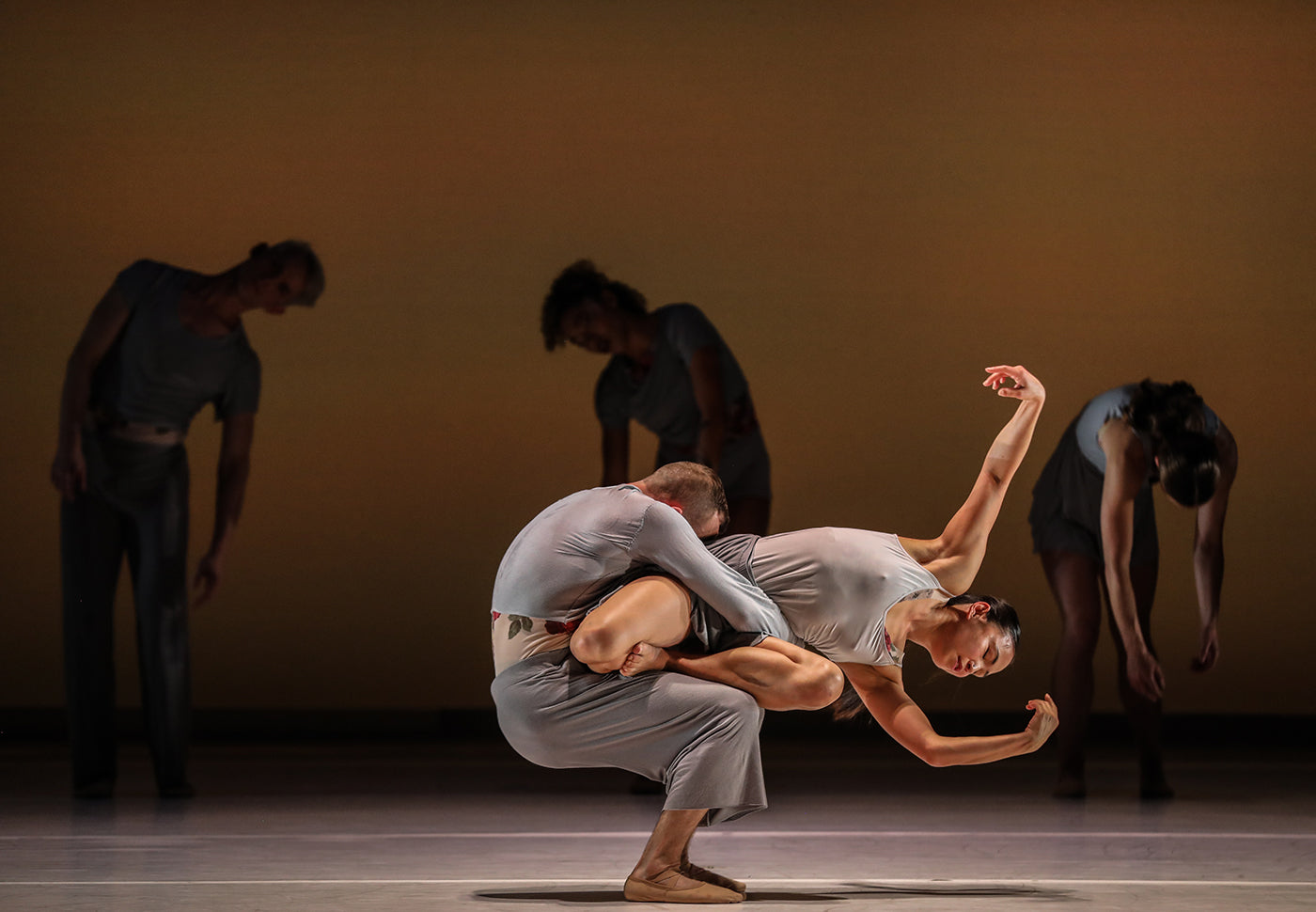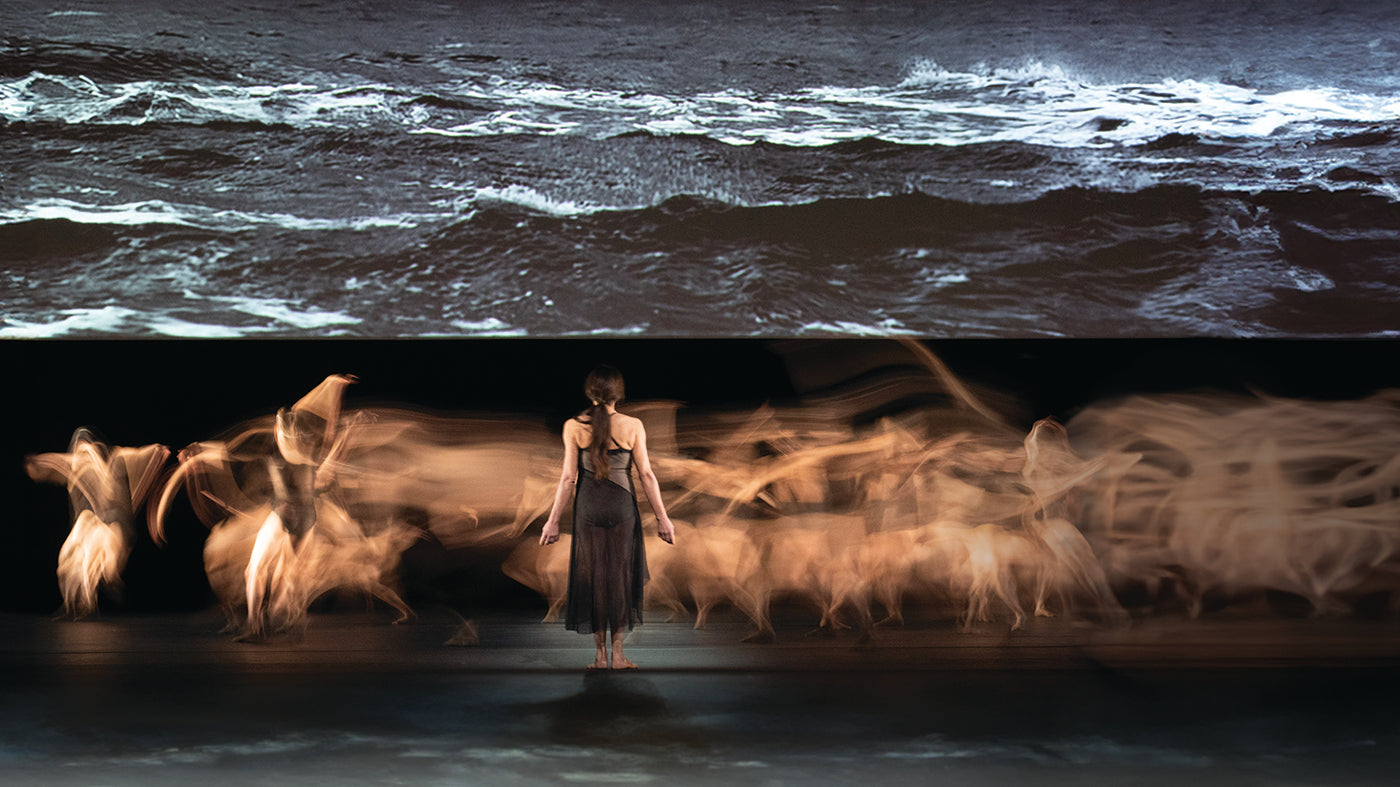Louise Brooks, Mary Pickford, Charlie Chaplin, Rudolf Klein-Rogge, Lingyu Ruan, Léon Mathot, and Lon Chaney. Those silent film stars, they were amazing. The things they could convey but with an expression. Their faces impart an intensely iconographic boldness that can make you uncomfortable. Think of those villains or those in peril with eyes wide, looming large before you; they are almost unreal.
There is a link between silent film and dance: expression. It was Alfred Hitchcock who said that the silent cinema was the purest form of acting, and Nederlands Dans Theater house choreographer Paul Lightfoot agrees. ‘Everything must be done without words. When you see those old movies now, you can actually understand them as choreography,’ he explains. The way those actors are capable of acting without words, using only their faces, their expression, their bodies, is just like choreography, like dance. Silent film seems a good way to introduce Move to Move, a film that features four ballets “Left Right Left Right,” “Silent Screen,” “Secus,” and “Shine a Light” in performance at the Lucent Theatre in Den Haag and shot specifically in high definition for the silver screen.
There are many links that tie these ballets and Hitchcock and silent film together, by way of a child’s nightmares (as explored in “Shine a Light”), and a look at how we move or could move from one place to the next (in “Left Right Left Right”). It was this and more which I saw “live” one Sunday at Carlton’s Cinema Nova watching NDT1 (the main company founded in 1959, and under the artistic direction of the aptly named Paul Lightfoot) and the younger company, NDT2 (founded in 1978, and under the artistic direction of Gerald Tibbs).
Whilst a film of a performance is second, some could and do say, to the thrill of live performance, there is still much beauty to immerse oneself in, head first, eyes open. There would be no other way of me seeing this performance if not for film. Films of operas, ballets, and plays, allow you to be transported. While I might prefer to see Franz Marc’s The Large Blue Horses (Die großen blauen Pferde was painted in 1911 and is currently in the collection of the Walker Art Center, Minneapolis) in person on the wall, looking at a printed version is better than not at all. This is how I used to feel about ballet shown as film: a good compromise. Compromise tied to an essentially affordable ticket price (though a little more than conventional cinema screenings). But Move to Move is more than that, and, to my mind, it is a film in its own right. It exists for more than this.
With six cameras in place to record every muscle twitch, confrontational gaze, and incredible contortion, seeing a performance in this way really does enable you to see all that normally you could not. Every subtle or otherwise movement is magnified, heightening the emotional intensity. It features behind-the-scenes footage of the stage being prepared and the dancers limbering up. It shows patrons checking in their bulky coats at the cloakroom, too, as the crowd masses and theatre fills. This we see before the lights dim and the dancers take to the stage, and it simulates the pre-show buzz that live theatre embraces and encourages. (Many in the movie house on Sunday took this as a chance not to revel in the delicious anticipation but to talk to one another as they wolfed down popcorn. Perhaps, for them, it was too inviting a chance to pass up and they conversed freely as you’d expect were we actually in the theatre. Perhaps they just fancied themselves important.) Front of house and behind the curtain, we are privy to all areas, almost, and this makes for intoxicating fly-on-the-wall stuff. It reminds me of an “elephant- or tiger-cam” in a David Attenborough nature documentary. (Or 2009’s La Danse directed by Frederick Wiseman, which follows the production of seven ballets by the Paris Opera Ballet.) It offers a new entry point, this technique. We get to view the theatre fill, from the position of outsider, before being whisked back stage to view proceedings from a more intimate standing, as an insider. Choreographers and dancers introduce each piece to us, and us alone, it feels. This is no ordinary recording of a performance.
Of the ballets performed, I have been lucky enough to see Sol León and Paul Lightfoot’s “Silent Screen” live when the company visited Melbourne in July 2011. It was the third ballet they presented, alongside Jiří Kylián’s “Double You” and Crystal Pite’s “The Second Person,” each unlike anything before I had witnessed. A new word they’ve added to the lexicon. To be able to see “Silent Screen” once more, and this time know a little of what was in store only added to my excitement. The evocative, and instantly recognisable Philip Glass score (Glassworks (1982), and The Hours soundtrack (2002)) makes this abstract journey an emotional one. As with the great silent films of Jean Epstein, an abstract tale may reject narrative, but this does not mean that the story that unfolds is one lacking drama and emotion. Think of those black-and-white films you have seen, of the body language the actors expressed through eyes and movement, and the optical illusion, that beautiful eye-deception of trompe-l’œil that lets you think there are more dancers on the stage than actually are. It is this, this drama and tragedy by way of Hitchcock, which you can see in “Silent Screen,” and the playing-with-the-audience film shown within a film. (It is interesting to note that the small child who features in the film shown projected behind the dancers is actually the choreographer’s own daughter.)
Sol León and Paul Lightfoot’s most recent work, “Shine a Light,” came together in a two and a half week period, they tell us during intermission. “Step Lightly,” “Solitaire,” “Susto,” “Start to Finish,” “Shoot the Moon,” “Sleight of Hand,” “Swan Song:” as with their previous ballets, the letter S serves as a playful and familiar signpost. “Shine a Light” is based on the nightmares of a little girl and the sounds that dreams have when we recall them upon waking. Fears are the inspiration and it is truly a dark and fearful work, with its dancers who creep and prowl and draw ever closer to you. Sol León remarked that she likes how the title implies a nightlight left on for a sleeping child. The costumes of the four male dancers have diagonal braces that slash across their chests and look, at first, like deep gashes that reveal a black or blank cavity where a body ought to be. Or like ink drawn. But, just like a dream or a nightmare, a closer look and we see something different. The costumes in this piece illustrate the artist Francis Bacon’s words that echo the work’s intention: ‘In order for the light to shine so brightly, the darkness has to be present.’ Shine a Light is like a drawing in the sense of the balance of light and shade, or chiaroscuro, the clear and bright held in perfect balance by the dark and obscure.
Alexander Ekman’s “Left Right Left Right” has brilliant energy and it makes one think not of running away to join a circus but to join NDT2. This playful piece stays with me as I think about how we travel through our day. As one of the dancers states, it really would be more fun to see people walking like a crab, or leaping, scuttling or rolling to work. As with the other ballets we see in the film, including Ohad Naharin’s “Secus,” control, and a carefully held balance of beauty and power is brought to the fore. The use of the repeated motif in “Secus” creates the impression of all the dancers moving as though part of one giant cohesive body. In the opening of “Left Right Left Right” the dancers stand side-on with their necks thrust forward and their faces spun round, looking out at the audience. They call to mind a pack of sculpted zombies. This ability to transform from one expression, pose, feeling to another is what makes them and the ballets they perform so beautiful. Movement and expression are everything, and I forget that I am in the cinema watching a film. Film can and does transport.









comments